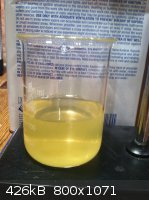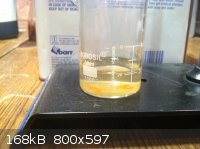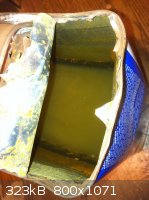Nitrator
Harmless

Posts: 27
Registered: 29-9-2012
Member Is Offline
Mood: No Mood
|
|
Apparent decomposition of stored acetone
After several years of storage, my acetone has "gone bad" in the most peculiar manner. It has been stored in one of those square metal containers
which one finds in the hardware store. Upon purchase ~3 years ago I poured some into a glass bottle, the rest was left in the metal can. The acetone
seems to be at least decently pure, as all the reactions I have used it for have turned out very well, AP synthesis etc. Upon using
up the acetone from the bottle today, I opened up the can and found this (first picture).
Now for the known facts:
Can was impossible to open (literally spent 30 mins trying to open), so I poked a hole in it with a can opener.
Liquid will not ignite.
Can first smelled of acetone but there is no longer a noticeable smell of acetone, indicating what little remained has evaporated.
Liquid does not boil till 101 C, indicating an aqueous solution.
After a few mins of boiling, the mixture separates some (second image).
Will not dissolve styrofoam.
It seems as though the acetone has completely reacted with the metal and produced water and some sort of iron compound... I have never heard of
acetone reacting with steel, nor do I know how such a reaction would occur, albeit I'm rather rusty on my chemistry at the moment. Any insight would
be much appreciated as I am very perplexed.
|
|
|
Burner
Hazard to Others
  
Posts: 100
Registered: 28-3-2014
Member Is Offline
Mood: No Mood
|
|
Did you have the acetone stored over a drying agent such as MgSO4? If so that would be the problem. These promote aldol condensations.
|
|
|
forgottenpassword
Hazard to Others
  
Posts: 374
Registered: 12-12-2013
Member Is Offline
Mood: No Mood
|
|
It sounds like the acetone was contaminated with water.
|
|
|
woelen
Super Administrator
        
Posts: 7976
Registered: 20-8-2005
Location: Netherlands
Member Is Offline
Mood: interested
|
|
Are you sure the acetone was pure. Since a few years, there is so-called 'acetone eco', which is a mix of acetone with water and some other organics.
This certainly can be used for making AP, but it has other crap in it as well and is not pure acetone. I can imagine that the acetone part has
evaporated, while the water and higher boiling organics are left behind.
In the Netherlands acetone is being phased out and replaced by such eco-crap:
http://www.pearlpaint.nl/nl/merken-producten/eco-line/aceton...
I can imagine that the same happens in other places and that your acetone was such a mix. It still is called acetone in most places and that is very
confusing, because in reality it is a blend of many different chemicals. If you look at the bottle in detail, then you can read that it is a blend of
different chemicals.
|
|
|
Nicodem
|
Thread Moved
7-5-2014 at 05:27 |
Nitrator
Harmless

Posts: 27
Registered: 29-9-2012
Member Is Offline
Mood: No Mood
|
|
The acetone was not stored over a drying agent.
It indeed seems as though the acetone was contaminated with water, however the volume remaining inside the can is close to the volume when initially
stored. I can't imagine that the acetone I've been working with this whole time has only been like 20% acetone. For instance, if I ever left some
out or spilled it, it would evaporate very quickly, never leaving behind any liquid. It seems as though the acetone must have reacted/decomposed/etc.
into water and yellow gunk while inside the can. And I just now looked up the msds for the product number and it is indeed 100% acetone.
Is there any way acetone can react with steel? Perhaps with some sort of small impurity that acts as a catalyst? What test could I do to identify
the products? I would like to know what is inside the can, and perhaps we could theorize how acetone, steel, and possibly x reacted.
|
|
|
Chemosynthesis
International Hazard
    
Posts: 1071
Registered: 26-9-2013
Member Is Offline
Mood: No Mood
|
|
Seems a little wild to me, but I guess it may be possible your acetone was subjected to conditions where it may have self-condensed into diacetone
alcohol and possibly mesityl oxide, which can react with transition metals under some conditions due to their pi system coordination.
Examples: DOI:10.1080/00372367208058975
Russian Journal of Organic Chemistry . May2005, Vol. 41 Issue 5, p649-655. 7p.
http://dx.doi.org/10.1016/j.ces.2007.01.045
|
|
|
Etaoin Shrdlu
National Hazard
   
Posts: 724
Registered: 25-12-2013
Location: Wisconsin
Member Is Offline
Mood: Insufferable
|
|
Acetone self-condenses to diacetone alcohol, which dehydrates into mesityl oxide, which can further react to give isophorone. You could get a fair bit
of water that way, but I'd be somewhat surprised to see this happen by accident at room temperature (if it has happened this warrants close
investigation). I'd also expect the result to still have a significant smell, and to chew up styrofoam like crazy.
I keep diacetone alcohol in steel containers as a matter of course; it's not known to react with them under most conditions and this again would
surprise me. I have no experience with mesityl oxide but that one would surprise me even more.
If your acetone reacted with something to produce water and a solid, you shouldn't have nearly as much liquid as before. Is it possible you emptied
the container and stored wastewater at some point, or that someone else might have done so?
Where are the pictures? Is it a glitch with my browser that I can't see them? I'm very curious about what happened here.
|
|
|
Chemosynthesis
International Hazard
    
Posts: 1071
Registered: 26-9-2013
Member Is Offline
Mood: No Mood
|
|
Isophorone could also theoretically pi backbond in a manner similar to mesityl oxide with transition metals. The citations I listed had iron and
chromium (probably present in a metal storage can) complexing with a mesityl chloride ligand in THF under UV irradiation.
Still dubious to me, but possible. With excess metal, the prominent odor of mesityl oxide may not be detectable after a duration of time, or masked
under acetone vapors.
|
|
|
Etaoin Shrdlu
National Hazard
   
Posts: 724
Registered: 25-12-2013
Location: Wisconsin
Member Is Offline
Mood: Insufferable
|
|
Apologies, I don't have access to most journals due to working in industry and "this isn't even a tiny bit related to what you do." (Am I bitter about
this? NO NEVER NOT AT ALL.  ) So, the details escape me, though I did read the
abstracts. Taylor and Francis abstracts are terrible. Trade-secret commercialism terrible. "We definitely did something with something else" but zero
mention of how and obfuscation of most of the reagents used. I can get straighter answers out of salespeople. ) So, the details escape me, though I did read the
abstracts. Taylor and Francis abstracts are terrible. Trade-secret commercialism terrible. "We definitely did something with something else" but zero
mention of how and obfuscation of most of the reagents used. I can get straighter answers out of salespeople.
I'd still be surprised if this was the main explanation for what happened. Spontaneously, in a can, the condensation and the dehydration
and the reaction with metal, enough complex formed to eliminate the organic solvents to the point where they're barely smellable but the can
itself wasn't corroded through...
Did they have solubility data for the iron complex, or information on the appearance? If the "yellow gunk" dissolves in organic solvents but not in
water that would at least be one step in narrowing down what it might be.
|
|
|
HgDinis25
Hazard to Others
  
Posts: 439
Registered: 14-3-2014
Location: Portugal
Member Is Offline
Mood: Who drank my mercury?
|
|
Try adding some NaOH. If there's Iron ions they should precipitate out.
The trouble opening the can puzzles me. It seems that it made some sort of glue? Adol condensation doesn't explain that.
Woelen, he said that the acetone was kept for several years, meaning it was bought several years ago. The eco bullcrap is more recent than that, so I
doubt it's going to be a mixture.
I also though of Ethyl Acetate. I've seen Ethyl Acetate being sold as "Aromatic Solvent" and I've seen many comerciants refering to it as Acetone.
Over the time, the small quantity of Acetic Acid produced by the hydrolisys could react with the can. Not very plausible since you claimed that you
made AP from it.
Are you sure the contents of the can haven't been swamped?
|
|
|
Burner
Hazard to Others
  
Posts: 100
Registered: 28-3-2014
Member Is Offline
Mood: No Mood
|
|
Was it possible that when you used the acetone it might have been exposed to a strong acid vapor (eg. HCl)?
|
|
|
Dr.Bob
International Hazard
    
Posts: 2658
Registered: 26-1-2011
Location: USA - NC
Member Is Offline
Mood: No Mood
|
|
The lid was hard to open due to rust, like any old steel can. Your acetone may have undergone some amount of aldol chemistry, which can keep going
due to water formed being partly eaten up by iron to form rust in the can, along with some air that leaked in slowly. Some the acetone could be
contaminated with several things but should have had some acetone remaining it in. Or maybe someone borrowed some acetone and replaced it with water
to hide the theft. Not likely, but as likely as acetone turning into water. However, it could well have self condensed into a mixture of crud, I
have seen this happen when people try to dry it, or with strong base, maybe the iron oxide acted as a catalyst.
|
|
|
Nitrator
Harmless

Posts: 27
Registered: 29-9-2012
Member Is Offline
Mood: No Mood
|
|
Ah, here are the pictures, sorry.

 
I'll test for iron cations with hydroxide as suggested, as well as seeing if any of the solid will dissolve in a non polar solvent. Rust does indeed
seem to be the reason the can was difficult to open, the inside is splotched with yellow orange rust. The can is stored in my laboratory and I find
it highly unlikely that anyone would tamper with it, nor is it remotely possible that I would have stored water in it myself. I'll have to spend some
time reading about aldol formation, as my knowledge of organic chemistry is quite lacking and I've been away from my lab for quite some time. I'll
get back shortly, thanks for all the suggestions so far!
|
|
|
Etaoin Shrdlu
National Hazard
   
Posts: 724
Registered: 25-12-2013
Location: Wisconsin
Member Is Offline
Mood: Insufferable
|
|
If you're in the US, would you be willing to send me some of this?
Dr. Bob, I came here to post something similar. I ran across several pounds of ferric acetylacetonate that we're not using, it got me to wondering
what effect iron might have here beyond simply complexing with reaction products, and a very cursory search does show some evidence for using
iron(iii) compounds to catalyze aldol condensations (unfortunately Google's "synonyms" for chemical-related searches are shaky to say the least and a
lot of my results are just indexes with no relevancy). I haven't had time to do much digging but will when I get back home.
[Edited on 5-8-2014 by Etaoin Shrdlu]
|
|
|
Nitrator
Harmless

Posts: 27
Registered: 29-9-2012
Member Is Offline
Mood: No Mood
|
|
I'd be more than happy to send you a quantity for testing, however, I'd imagine it's not legal to mail this, as I don't know for sure what it is, or
may contain... In a few days, I'll be able to run some rudimentary tests and hopefully at least give us some definitive clues as to what the products
may be. As I have mentioned before hand, I am unfamiliar with this aldol condensation stuff, and will research it as soon as possible. Any specific
tests which test for reactants of aldol condensations, would likely speed things up if mentioned.
|
|
|
Texium
Administrator
       
Posts: 4508
Registered: 11-1-2014
Location: Salt Lake City
Member Is Online
Mood: PhD candidate!
|
|
I have a similar can of acetone which I kept on the same shelf as a gallon jug of HCl from the hardware store, and the top of the can became covered
with rust within a matter of weeks. If you had it stored near any HCl or other corrosive vapors, maybe it is possible that the vapors infiltrated the
can and reacted with the metal on the inside too? It's a bit difficult to tell in the picture, but the outside of the can has rusted heavily, right?
What else did you store near it?
|
|
|
Nitrator
Harmless

Posts: 27
Registered: 29-9-2012
Member Is Offline
Mood: No Mood
|
|
Hmm... There is actually two gallon jugs of HCl stored on the same shelf. Wow, quite astonishing, and quite suggestive of an acid
catalyzed aldol condensation. Yes, the top is indeed rusted with a chocolate brown rust, however it does not seems as though it comes anywhere near
going through the metal. Perhaps it traveled underneath the cap? This seems quite unlikely to me due to the high vapor pressure of acetone.
Regardless, this coincidence is certainly suggestive, as most posters suspected aldol condensation to begin with.
What else did I store near it? Well the only other volatile chemicals in the same cabinet are Ammonia, Bleach, MEK, Toluene, Ethanol, and
Isopropanol.
|
|
|
Burner
Hazard to Others
  
Posts: 100
Registered: 28-3-2014
Member Is Offline
Mood: No Mood
|
|
Bases can also catalyze aldol condensations, so the Ammonia is a suspect. However, I am wondering if Chlorine from the bleach might be the real
culprit. Need to do a bit of digging.
|
|
|
Burner
Hazard to Others
  
Posts: 100
Registered: 28-3-2014
Member Is Offline
Mood: No Mood
|
|
Also, I suspect that the cans of acetone underwent a bit of "breathing" as a result os major temperature changes over the past many months and that
may have entrained minor amounts of the acid or base catalyst vapors into the cans. If so that would definitely be a new item for my experience bank.
[Edited on 10-5-2014 by Burner]
|
|
|